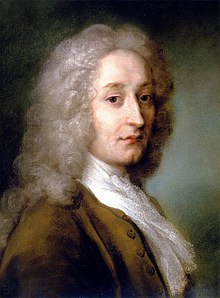Antoine Watteau | |
|---|---|
 Rosalba Carriera, Portrait of Antoine Watteau, c. 1721, showing the artist in the last year of his life. Musei Civici, Treviso | |
| Born | Jean-Antoine Watteau baptised 10 October 1684 |
| Died | 18 July 1721 (aged 36) |
| Nationality | French |
| Education | |
| Known for | Painting and drawing |
| Notable work | Embarkation for Cythera, 1717–1718 L'Enseigne de Gersaint, 1720–1721 |
| Movement | Rococo |
| Patron(s) | |
Jean-Antoine Watteau (UK: /ˈwɒtoʊ/, US: /wɒˈtoʊ/,[2][3] French: [ʒɑ̃ ɑ̃twan vato]; baptised 10 October 1684 – died 18 July 1721)[4] was a French painter and draughtsman whose brief career spurred the revival of interest in colour and movement, as seen in the tradition of Correggio and Rubens. He revitalized the waning Baroque style, shifting it to the less severe, more naturalistic, less formally classical, Rococo. Watteau is credited with inventing the genre of fêtes galantes, scenes of bucolic and idyllic charm, suffused with a theatrical air. Some of his best known subjects were drawn from the world of Italian comedy and ballet.
- ^ Cite error: The named reference
Levwas invoked but never defined (see the help page). - ^ Wells, John C. (2008). Longman Pronunciation Dictionary (3rd ed.). Longman. ISBN 978-1-4058-8118-0.
- ^ Jones, Daniel (2011). Roach, Peter; Setter, Jane; Esling, John (eds.). Cambridge English Pronouncing Dictionary (18th ed.). Cambridge University Press. ISBN 978-0-521-15255-6.
- ^ Wine, Humphrey; Scottez-De Wambrechies, Annie (1996). "Watteau". In Turner, Jane (ed.). The Dictionary of Art. Vol. 32. New York: Grove's Dictionaries. pp. 913–921. ISBN 1-884446-00-0 – via the Internet Archive. Also available via Oxford Art Online (subscription needed).